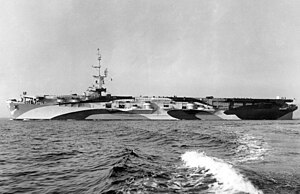Commencement Bay-class escort carrier
This article needs additional citations for verification. (July 2008) |
 USS Commencement Bay
| |
| Class overview | |
|---|---|
| Builders | list error: <br /> list (help) Todd Pacific Shipyards Seattle-Tacoma Shipbuilding Corporation |
| Operators | |
| Preceded by | Casablanca class escort carrier |
| Succeeded by | Iwo Jima class amphibious assault ship |
| Built | 1943–1945 |
| In commission | 1945–1971 |
| Planned | 33 |
| Completed | 19 |
| Cancelled | 14 |
| General characteristics | |
| Type | Escort carrier |
| Displacement | list error: <br /> list (help) 10,900 long tons (11,100 t) standard 24,100 long tons (24,500 t) full load |
| Length | 557 ft (170 m) |
| Beam | list error: <br /> list (help) 75 ft (23 m) 105 ft 2 in (32.05 m) flight deck |
| Draft | 30 ft 8 in (9.35 m) |
| Propulsion | 2-shaft geared turbines, 16,000 shp |
| Speed | 19 knots (22 mph; 35 km/h) |
| Complement | 1,066 officers and men |
| Armament | list error: <br /> list (help) 2 × 5"/38 caliber guns (1 × 2) 36 × 40 mm Bofors gun (3 × 4, 12 × 2) |
| Aircraft carried | 34 |
The Commencement Bay-class escort aircraft carriers were based on the Maritime Commission T3 type tanker hull, which gave them a displacement of approximately 23,000 tons and a length of 557 feet (170 m). Unlike most earlier CVE classes which were laid down as something else and converted to aircraft carriers mid-construction, the Commencement Bays were built as carriers from the keel up. Their general layout was similar to the Sangamon-class escort carriers, but some of the Sangamon's engineering shortcomings were addressed.
They entered service late in World War II — USS Commencement Bay launched on 9 May 1944 — so most of them saw little or no operational service. Thirty-three of them were ordered but many were cancelled prior to completion. Nineteen saw commissioned service in the US Navy, four were broken up on the ways at the end of the war, two were accepted from the builders, but never commissioned and the remainder were cancelled before being laid down.
After the war they were seen as potential helicopter, anti-submarine, or auxiliary (transport) carriers, and a number of ships served in these roles during the Korean War. The onrushing jet age ended their lives, as the ships were no longer large enough to safely carry the much larger jet aircraft of the late 1950s, and all units were out of service or reclassified by 1960.
Ships
- USS Commencement Bay (CVE-105)
- USS Block Island (CVE-106)
- USS Gilbert Islands (CVE-107)
- USS Kula Gulf (CVE-108) originally USS Vermillion Bay
- USS Cape Gloucester (CVE-109)
- USS Salerno Bay (CVE-110)
- USS Vella Gulf (CVE-111) originally named Totem Bay
- USS Siboney (CVE-112) originally named Frosty Bay
- USS Puget Sound (CVE-113)
- USS Rendova (CVE-114) originally named Mosser Bay, then Willamette
- USS Bairoko (CVE-115) originally named Portage Bay
- USS Badoeng Strait (CVE-116)
- USS Saidor (CVE-117) originally named Saltery Bay
- USS Sicily (CVE-118) originally named Sandy Bay
- USS Point Cruz (CVE-119) originally named Trocadero Bay
- USS Mindoro (CVE-120)
- USS Rabaul (CVE-121)
- USS Palau (CVE-122)
- USS Tinian (CVE-123) never commissioned
- USS Bastogne (CVE-124) cancelled
- USS Eniwetok (CVE-125) cancelled
- USS Lingayen (CVE-126) cancelled
- USS Okinawa (CVE-127) cancelled
